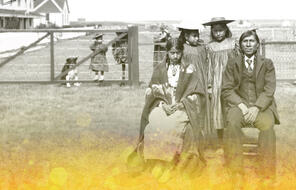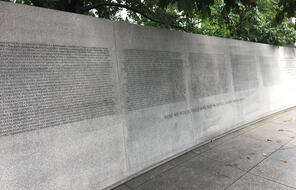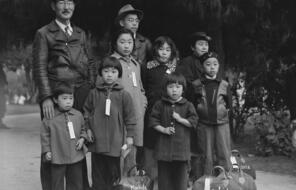The Churches Apologize
In the late 1970s, the churches of Canada were coming under increasing scrutiny because they were so closely identified with the colonial project of civilizing and Christianizing the Indigenous Peoples, operating the residential schools, and the disastrous consequences of both. Still, not much happened, at least not publicly. But on an ordinary day in 1981, Indigenous activist Alberta Billy stood up and told the United Church Executive General Council: “The United Church owes the Native peoples of Canada an apology for what you did to them in residential school.” 1 This bold statement left many members of the council speechless. Five years later, after much discussion and soul searching, the Rt. Rev. Robert Smith delivered the apology below in the name of the United Church. 2
Long before my people journeyed to this land your people were here, and you received from your Elders an understanding of creation and of the Mystery that surrounds us all that was deep, and rich, and to be treasured. We did not hear you when you shared your vision. In our zeal to tell you of the good news of Jesus Christ we were closed to the value of your spirituality. We confused Western ways and culture with the depth and breadth and length and height of the gospel of Christ. We imposed our civilization as a condition for accepting the gospel. . . . As a result you, and we, are poorer and the image of the Creator in us is twisted, blurred, and we are not what we are meant by God to be. We ask you to forgive us. 3
The Canadian Catholic Church did not have a collective role in the residential schools; decisions were often made by individual dioceses and orders. It also did not make a collective apology for the role the various dioceses played in the residential schools system . Pope Benedict XVI met Aboriginal leaders in 2009 and expressed his sorrow for the experiences of the residential school survivors. Many critics argue that this was not a full apology. 4 Individual bishops did apologize, following the example of the Missionary Oblates of Mary Immaculate. This order, in charge of the largest number of the residential schools, offered this apology in 1991:
Next year, 1992, marks the five hundredth anniversary of the arrival of Europeans on the shores of America. As large scale celebrations are being prepared to mark this occasion, the Oblates of Canada wish, through this apology, to show solidarity with many Native people in Canada whose history has been adversely affected by this event. . . . As well, recent criticisms of Indian residential schools and the exposure of instances of physical and sexual abuse within these schools call for such an apology. . . . We apologize for the part we played in the cultural, ethnic, linguistic, and religious imperialism that was part of the mentality with which the Peoples of Europe first met the aboriginal peoples and which consistently has lurked behind the way the Native peoples of Canada have been treated by civil governments and by the churches. We were, naively, part of this mentality and were, in fact, often a key player in its implementation. We recognize that this mentality has, from the beginning, and ever since, continually threatened the cultural, linguistic, and religious traditions of the Native peoples.
We recognize that many of the problems that beset Native communities today—high unemployment, alcoholism, family breakdown, domestic violence, spiraling suicide rates, lack of healthy self-esteem—are not so much the result of personal failure as they are the result of centuries of systemic imperialism. Any people stripped of its traditions as well as of its pride falls victim to precisely these social ills. For the part that we played, however inadvertent and naive that participation might have been, in the setting up and maintaining of a system that stripped others of not only their lands but also of their cultural, linguistic, and religious traditions we sincerely apologize. . . .
In sympathy with recent criticisms of Native Residential Schools, we wish to apologize for the part we played in the setting up and the maintaining of those schools. We apologize for the existence of the schools themselves, recognizing that the biggest abuse was not what happened in the schools, but that the schools themselves happened . . . that the primal bond inherent within families was violated as a matter of policy, that children were usurped from their natural communities, and that, implicitly and explicitly, these schools operated out of the premise that European languages, traditions, and religious practices were superior to native languages, traditions, and religious practices. The residential schools were an attempt to assimilate aboriginal peoples and we played an important role in the unfolding of this design. For this we sincerely apologize.
We wish to apologize in a very particular way for the instances of physical and sexual abuse that occurred in those schools. . . . Finally, we wish to apologize as well for our past dismissal of many of the riches of native religious tradition. We broke some of your peace pipes and we considered some of your sacred practices as pagan and superstitious. This too had its origins in the colonial mentality, our European superiority complex, which was grounded in a particular view of history. We apologize for this blindness and disrespect. . . .
. . . Sincerity alone does not set people above their place in history. Thousands of persons operated out of this mentality and gave their lives in dedication to an ideal that, while sincere in its intent, was, at one point, naively linked to a certain cultural, religious, linguistic, and ethnic superiority complex. These men and women sincerely believed that their vocations and actions were serving both God and the best interests of the Native Peoples to whom they were ministering. History has, partially, rendered a cruel judgment on their efforts. . . .
Recognizing that within every sincere apology there is implicit the promise of conversion to a new way of acting. We, the Oblates of Canada, wish to pledge ourselves to a renewed relationship with Native Peoples which, while very much in line with the sincerity and intent of our past relationship, seeks to move beyond past mistakes to a new level of respect and mutuality …
Reverend Doug Crosby OMI
President of the Oblate Conference of Canada
On behalf of the 1200 Missionary Oblates of Mary Immaculate living and ministering in Canada 5
Finally, in 1992, the Anglican Church, too, offered an apology. It came about late and after years of internal changes and criticism, similar to the changes the Catholic orders went through. Primate Archbishop Michael Peers offered a shorter apology in the name of the Anglican Church. Here are the key sentences from the apology: “I am sorry, more than I can say, that we were part of a system which took you and your children from home and family. I am sorry, more than I can say, that we tried to remake you in our image, taking from you your language and the signs of your identity. I am sorry, more than I can say, that in our schools so many were abused physically, sexually, culturally and emotionally. On behalf of the Anglican Church of Canada, I present our apology.” 6
Connection Questions
- How would you define the term apology? What purposes do apologies serve? What are the qualities of a good apology?
- What “confusion” did the United Church admit to? Read its apology carefully.
- What did Reverend Doug Crosby apologize for in his statement from the Conference of Oblates? What responsibility does he take? What words does he use to describe the intent of the Oblates in the past?
- Reverend Crosby wrote: “We apologize for the existence of the schools themselves, recognizing that the biggest abuse was not what happened in the schools, but that the schools themselves happened.” What point was he trying to make?
- The Anglican apology reads: “I am sorry, more than I can say, that we tried to remake you in our image, taking from you your language and the signs of your identity.” What is Archbishop Michael Peers, who delivered the statement, apologizing for? What does he mean by “we tried to remake you in our image”? How is that idea related to the idea of assimilation ? What religious echoes are found in the statement? What might they mean?
- How do these apologies measure up to the qualities of a good apology that you listed in response to question 1?
- IndigenousIndigenous: A generic term for communities of people who resided on territories before they were invaded and/or colonized (primarily by Europeans). Many descendants of these communities have a historical and cultural continuity with their pre-colonial ancestors. For some, the term Indigenous is preferable to Aboriginal in reference to the First Nations, Métis, and Inuit in Canada.
- 1Martha Troian, “25 Years Later: The United Church of Canada’s Apology to Aboriginal Peoples,” Indian Country Today Media Network, accessed November 17, 2014.
- 2The United Church was formed in 1925 as a union of the Congregationalist, Methodist, and Presbyterian Churches. It oversaw the operation of 13 to 15 residential schools (roughly 10% of the total). It made a more sweeping apology in 1998 and has committed itself since to working closely with Indigenous communities to meet their needs and expectations.
- 3“Apology to First Nations Peoples (1986),” United Church of Canada website.
- residential schools systemresidential schools system: Beginning in 1883, the federal government sought a system to enroll Indigenous children in schools. The residential schools system was part of a larger government agenda to assimilate Indigenous people into settler society by way of education. Relying almost exclusively on churches to provide the teachers, administrators, and religious instructors, the system was severely underfunded and marked by inferior educational standards and achievement: neglect, malnutrition, abuse, and disease were widely reported. In recent years, researchers discovered that some schools even carried out dangerous medical experiments. It is also estimated that more than 6,000 students died of disease and abuse while enrolled. Over a 150-year span, the government and churches operated close to 150 schools where some 150,000 Indigenous youth were enrolled.
- AboriginalAboriginal: Stemming from the mid-seventeenth-century Latin term aborigines, meaning “original inhabitants,” Aboriginal is the preferred legal term in Canada for the large and diverse grouping of First Nation, Métis, and Inuit nations. It is used synonymously with the term Indigenous in various parts of Canada.
- 4“The Residential School System,” University of British Columbia Indigenous Foundations website, accessed September 11, 2014.
- 5Missionary Oblates of Mary Immaculate, “An Apology to the First Nations of Canada by the Oblate Conference of Canada,” Canadian Conference of Catholic Bishops, accessed November 17, 2014.
- 6“The Apology—English,” Anglican Church of Canada, accessed November 17, 2014.
- assimilation[assimilation]: This term refers to the process whereby one group or individual’s culture is absorbed into another, creating one single cultural entity, giving up distinct group or individual identity. Believing that Indigenous cultures were inferior, the Canadian government, since the middle of the nineteenth century, put forth a series of policies to assimilate the Indigenous Peoples into settler Canadian society.
How to Cite This Reading
Facing History & Ourselves, "The Churches Apologize," last updated September 20, 2019.















